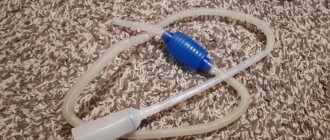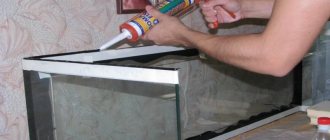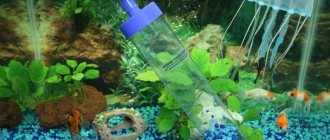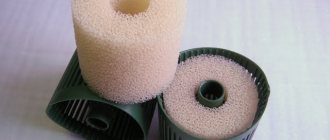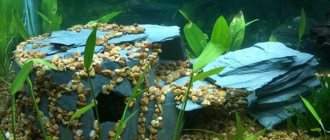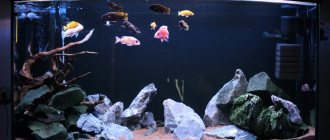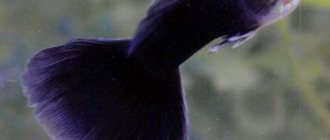Now all people who have an aquarium can purchase various accessories for it. It should be noted that certain conditions must be created for the fish. It is necessary to have additional lighting, maintain the correct water temperature, and also regulate the soil. Without these procedures and devices, fish will not be able to live long.
In order to clean the aquarium, you must use a siphon. We'll talk about how to use a siphon for an aquarium later. Thanks to it, you can remove all the dirt, food residues, and waste that the fish leave behind. The same design can reduce the level of bad substances in the water, and it will also prevent siltation of the soil.
What types of siphons are there?
We have already figured out what a siphon for cleaning an aquarium is, now we need to discuss its types and methods of operation. Such devices are available in mechanical and electrical types. The first one should include a siphon, which is equipped with a check valve. These cleaners consist of pear. It is she who absorbs water. A hose and a special transparent funnel are connected to it. In order to prevent the absorption of stones and fish, the device must be transparent. Mechanical devices have one drawback. It consists in the fact that it is necessary to drain the water. Care should be taken that its volume does not exceed 30%.
Siphons can also be produced with batteries. They are considered more convenient. Such devices do not require draining the liquid, since there is no hose. Such a device is capable of absorbing water well. It passes through a special pocket where debris remains and returns to the aquarium. Battery-powered aquarium siphons do not take up much space and have a motor and a funnel. The disadvantage of such a device is that it is prohibited to use a battery-powered device at a depth of more than half a meter. Otherwise, water may get into the battery compartment, which means the siphon will break.
Principle of operation
The easiest way is to compare an aquarium siphon with a pump. The device creates a vacuum at the end of a special pipe, due to which water and liquid waste are pumped into it.
The principle of operation of the siphon is simple. One end of the hose or tube is connected to the contaminated soil. At the other end there may be either a water filter from which it will flow back into the aquarium (electric siphon), or a flexible tube that is lowered into an empty container below the bottom (mechanical siphon).
The larger the diameter of the tube, the faster the water will be pumped out of the aquarium. In the case of mechanical siphons, the lower the outer end of the tube is located, the greater the draft.
How to siphon soil?
After a person decides on the mechanism of the device, it is necessary to understand exactly how to siphon the soil. It doesn’t matter what type of device or model was chosen, the cleaning method is the same. The funnel must be lowered vertically to the bottom, then the process itself begins. You need to continue this until the water becomes completely clear and free of any debris. After this, the funnel should be moved to another area.
It is worth noting that cleaning an aquarium is a rather lengthy process. The procedure will take at least about an hour. It is necessary to go over the entire soil, otherwise cleaning the aquarium makes no sense. If a person uses a siphon to clean the soil of a mechanical aquarium, then one must remember the above-described 30%, which cannot be exceeded before draining.
To clean the middle of the bottom, you can use large funnels; for corners and decorations, you should use special nozzles, which can be purchased separately. If plants are planted at the bottom of the aquarium, then it is necessary to carefully clean it, otherwise there is a risk of damaging the roots. In such cases, professionals recommend using special models that can be purchased at a pet store. This siphon has a metal tube, the end of which is only 2 millimeters. A drain hose is connected to it.
In order to speed up the cleaning process and protect the plants, use devices with small holes. This device is suitable for any type of soil, except sand. In order to drain the water, you need to prepare a container. If we are talking about a large aquarium, it is best to use a long hose that can be reached to the nearest sink or bathroom. If there is a risk that fish may get into the device, you should use a siphon with a special mesh filter. All large objects will be trapped in it. After mechanical cleaning, fresh water is poured into the aquarium.
What to do with sand after siphoning?
If fine sand gets into the drainage container or is clogged in the siphon, you must return it to the aquarium, after first rinsing it with running water. To do this, at best, you will have to remove the protective grille; at worst, you will have to completely disassemble the siphon or cut the hose if a large, stubborn stone is stuck in it.
The recommended frequency of siphon cleaning depends on the number of aquarium pets: from once a week to once a month.
It happens that aquarists are faced with the problem of greening of the soil and other surfaces in the aquarium. The green coating that grows on objects consists of unicellular algae, which can rapidly multiply under the influence of the following factors:
- Excessive light: Avoid placing the aquarium near a sunny window and turn off the lights at night.
- Overfeeding fish and irregular cleaning of the soil: it is necessary to give the fish as much food as they can eat in 5 minutes, otherwise the remaining food will remain at the bottom and rot.
- Poor soil ventilation: very small stones or sand contribute to rotting processes.
Another way out of the situation could be to introduce fish that like to eat small algae: platies, mollies or catfish. Or use a drug that kills algae and is harmless to aquarium fauna: these are sold in pet stores.
If you follow all the rules and have some skill, cleaning an aquarium using a siphon becomes a simple and safe procedure, the regular implementation of which will ensure a comfortable existence for your fish.
maintenance, care, compatibility
Adviсe
Professionals know how to use a siphon without any problems. But beginners have some difficulties, especially during their first use. That is why you need to pay attention to the following tips.
When a person chooses a siphon for himself, it is necessary to take into account the volume of the aquarium, what kind of soil is available, the number of decorations and plants planted. If we are talking about a nanoaquarium, then they sell special devices for them. You should not use standard ones, as they can harm the fish. If you couldn’t find such a device in the store, you can use a syringe and an IV tube.
If the device is too powerful, it can easily suck in fish. Therefore, you need to monitor the cleaning process as much as possible. The funnel should be lowered to its maximum depth. The lower it is, the better it will be to clean the bottom. If there are no plants on the site, then you can lower the tube to the entire depth of the soil. The pressure will be stronger if the tip is lowered. You should also place the end of the hose lower than the aquarium itself, because only in this position will the water begin to drain.
Recommendations for selection
Today, four brands are widely represented on the aquarium equipment market: Tetra (Russia), AQUAEL (Poland), EHEIM and HAGEN (Germany). When choosing a particular device, you need to pay attention to the extent to which it corresponds to the parameters of the aquarium and the needs of its inhabitants.
If the bottom quickly silts up, but changing the water is undesirable (for example, when breeding cryptocorynes), it is worth using a siphon with an electric motor and draining the liquid back into the aquarium. Owners of fish that are sensitive to changes in water characteristics can limit themselves to mechanical devices.
The diameter of the siphon hose should be slightly larger than that of the pebbles in the aquarium.
The pressure of the siphon for the aquarium must correspond to the density of the soil. Light fractions are best cleaned under low pressure. Otherwise, the device will absorb not only dirt, but also soil. Heavy fractions can be processed with a powerful siphon.
Choose a siphon with a tap to regulate the intensity of the water flow. This way you can set the optimal pressure.
The diameter of the hose for the siphon should be slightly larger than that of the pebbles in the aquarium. The optimal size is 0.8–1.2 cm. The thicker the tube, the greater the water flow.
If the device has a mesh in the intake, you won’t have to worry that the device will suck in pebbles or small creatures. Models equipped with a bag on the drain allow you to purify the water leaving the device. After this, you don’t have to settle it, but immediately pour it back in. However, if the aquarium has not been cleaned for a long time, then even a filter on the siphon will not help: the pumped out water will have to be replaced with fresh water.
DIY siphon
The most important element is the hose. If the siphon is expected to work with a 100-liter aquarium, then a tube with a diameter of 10 mm is suitable. If you use a thicker one, then during cleaning, before a person has time to clean the bottom, almost all the water will pour out. In order to avoid such troubles, you need to understand how to make a siphon for an aquarium with your own hands.
For a 50 liter aquarium you need to use a hose with a diameter of 5 mm. You should take a plastic bottle, syringes for 10 cubes, you need 2 of them, electrical tape, a knife and a brass outlet for the hose.
You need to take the syringe, remove the needle, and also remove the plunger. Using a knife, cut off the tabs from one of the syringes to create a tube. Next, you need to take the second syringe and cut it off from the side where the piston entered. But in the place where the needle was, you should make a hole, the diameter of which will be 5 mm. Using electrical tape, you can connect the resulting tubes. The tube that has the hole must remain outside. A hose should be inserted into it. Next, you need to take a plastic bottle and cut a hole in the lid, which will be 4 mm in diameter. The brass outlet should be inserted here. And you need to attach another piece of hose to it. Now the homemade siphon is ready.
In order for it to work, you need to immerse the wide end into the ground and take the bottle. After this, reverse draft will appear, debris from the bottom will rise. If you don't want to use a bottle, you can take a bucket. After the aquarium is a little empty, you need to fill it with fresh water.
Cleaning and storing the device
A DIY siphon is very easy to maintain and clean. Upon completion of cleaning the aquarium, you need to disassemble all parts and rinse thoroughly under running water. If desired, you can use a soapy solution to wipe down the funnel. After this, you need to rinse it well and dry it thoroughly with a cloth. It should be noted that all detergents can harm fish, so you need to thoroughly rinse all parts of the structure.
As needed, for example, when dirty stains are no longer washed off or deposits clog the hose, you can replace it or make a new design. Cleaning the soil in an aquarium using a siphon is a very important procedure that does not take much time and effort. To clean a structure with a capacity of 50 liters, 10-15 minutes are enough. The benefits of such a homemade device are invaluable.
EHEIM
A good German company is EHEIM. It should be noted that all professional aquarists know this manufacturer. The most popular siphons for aquariums are electric type, which operate on batteries. They weigh only about 600 g and do not require an additional drainage container. The device returns the purified water to the aquarium immediately.
This way, you can also save on buying new water. Due to the fact that the suction tube has jagged edges, the roots of aquatic plants will be preserved as much as possible. This aquarium siphon is suitable for a container that is designed for no more than 200 liters. The height of the walls should not exceed 0.5 m.
Among the disadvantages, it should be noted that the batteries discharge quite quickly, and the cost of the device itself is high. The first drawback will disappear if, instead of batteries, you install an adapter that allows you to power the device from the mains.
Review of professional equipment
Today, manufacturers of equipment for aquarium maintenance offer a large selection of siphons for cleaning soil of various types: cheap and expensive, mechanical, electrical, of various capacities, with sedimentation tanks and special valves. It is difficult to decide, at first glance, which device to give preference to. The main thing when choosing is not to rush and determine a specific model that is suitable for a particular case. Popular brands of cleaning equipment:
- EHEIM. If the aquarium owner prefers high-tech systems, then he will like the famous German products. The battery-powered electric device weighs 630 g. Despite its light weight, it effectively cleans the aquarium without draining the liquid. He immediately returns the purified water. The suction tube has serrated perforated edges. This is necessary in order to preserve the roots of the plants. This device is designed for containers up to 200 liters, the height of which is no more than 50 cm. The disadvantages of the device include the high cost and rapid discharge of the batteries. The last problem can be solved by installing an adapter so that the power comes from the electrical networks.
Electric siphon from the German company EHEIM is lightweight and efficient
- HAGEN is a company from Germany that is a leader in the production of cleaning siphons. The company has an extensive line of its products, the prices of which are not affordable for everyone. The electric device Hagen Marina Aqua Vac carefully and efficiently cleans the soil at the bottom, and also allows you to change the water using a 7-meter hose included with the device. The cost of this device is very high and amounts to about 6 thousand rubles. If purchasing a device is too expensive, you can buy a compact device from this company, which can be launched using a rubber bulb. In addition, to collect liquid you will need a container that needs to be installed below the aquarium. The cost of such a device is no more than 600 rubles.
- The Tetra company produces siphons of different capacities. Cost varies, but in general these cleaners are budget-friendly and high quality.
- AQUAEL. Many experts praise this Polish company. It creates lightweight and effective siphons for the soil in the aquarium. This company has been competing with German companies for a long time. Their big advantage is the low cost of production.
The choice of manufacturer depends on the budget and preferences of the buyer. Cleaning an aquarium is an important procedure for maintaining normal living conditions for its inhabitants. You can buy a special siphon ready-made or make it yourself and save a lot of money.
Tetra
It is famous. It provides the market with siphons that have different capacities. For example, the T-50 aquarium cleaning siphon will clean the soil well even in a 400-liter aquarium.
But the DC30 model will be convenient only for those aquariums whose volume is no more than 60 liters. Of course, the cost of such devices varies, but overall this is a good and budget option, given the German quality.
Cleaning a marine aquarium
If you want to thoroughly clean an ordinary marine tank, which is usually filled with various decorative elements, you will need to follow these rules:
Decorations can be cleaned inside the aquarium with a stiff brush or outside with a sponge; Modern detergents and household cleaners are not used; Be sure to remove all algae damaged by crawling snails or fish. You also need to get rid of eaten leaves.
The plant should not complicate the movement of aquatic inhabitants; If you do not plan to change the water during harvesting, you need to weed out the bushes very carefully, without raising the turbidity.
To save yourself from regular and tedious weeding, you should get special algae-eating fish. They will keep the water clean for a long time. If you use an additional magnet to clean the aquarium, you can get the best option for cleanliness.
If plants grow very quickly, if they acquire a brown tint, this indicates an unfavorable situation in the reservoir. It will be necessary to take certain measures to effectively control lower plant species.
